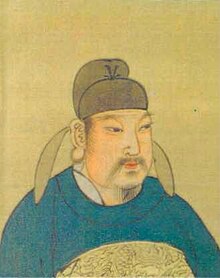| |||||||||
|---|---|---|---|---|---|---|---|---|---|
 | |||||||||
| Emperor of the Tang dynasty | |||||||||
| Reign | 25 April 846[1][2] – 7 September 859 | ||||||||
| Predecessor | Emperor Wuzong | ||||||||
| Successor | Emperor Yizong | ||||||||
| Born | 27 July 810[1][3] Daming Palace, Chang'an, Tang China | ||||||||
| Died | 7 September 859 (aged 49)[1][3] | ||||||||
| Burial | Zhen Mausoleum (貞陵) | ||||||||
| Consorts | Empress Yuanzhao | ||||||||
| Issue | () | ||||||||
| |||||||||
| House | Li | ||||||||
| Dynasty | Tang | ||||||||
| Father | Emperor Xianzong | ||||||||
| Mother | Empress Xiaoming | ||||||||
| Chinese name | |||||||||
| Chinese | 唐宣宗 | ||||||||
| Literal meaning | "Declared Ancestor of the Tang" | ||||||||
| |||||||||
| Li Yi | |||||||||
| Chinese | 李怡 | ||||||||
| Literal meaning | (personal name) | ||||||||
| |||||||||
Emperor Xuanzong of Tang (27 July 810 – 7 September 859) was an emperor of China's Tang dynasty, reigning from 25 April 846 until his death. Personally named Li Yi, later renamed Li Chen (Chinese: 李忱), and known before his reign as the Prince of Guang, he was considered the last capable emperor of Tang China. Succeeding emperors after Xuanzong would either be too young or be dominated by eunuchs or warlords. Emperor Xuanzong was the 13th son of Emperor Xianzong (r. 806–820) and an uncle of the previous three emperors, Emperor Jingzong, Emperor Wenzong, and Emperor Wuzong.
To distinguish Emperor Xuanzong from his ancestor Emperor Xuánzong (personal name Li Longji), as their memorial names are rendered identically in Wade–Giles and when pinyin tonal marks are not used, Xuanzong is occasionally referred to as Xuanzong II in western sources;[5] in Chinese, however, their memorial titles (宣宗 for him and 玄宗 for Li Longji) are clearly distinct and this device is not used.
- ^ a b c d e Academia Sinica Chinese-Western Calendar Converter. Archived 22 May 2010 at the Wayback Machine
- ^ a b Zizhi Tongjian, vol. 248.
- ^ a b Old Book of Tang, vol. 18, part 2.
- ^ Zizhi Tongjian, vol. 250.
- ^ Duan, Wenjie (1994). Dunhuang Art: Through the Eyes of Duan Wenjie. Abhinav Publications. p. 173. ISBN 978-81-7017-313-7.